Giuseppe Verdi was a master of melody, crafting some of the most unforgettable tunes in opera history. His genius lay not only in his ability to write soaring and emotionally charged arias but also in his profound understanding of how music could reflect the inner turmoil and triumphs of his characters. Verdi’s melodies, whether grand, majestic or tender and intimate, have a visceral quality that cuts straight to the heart.
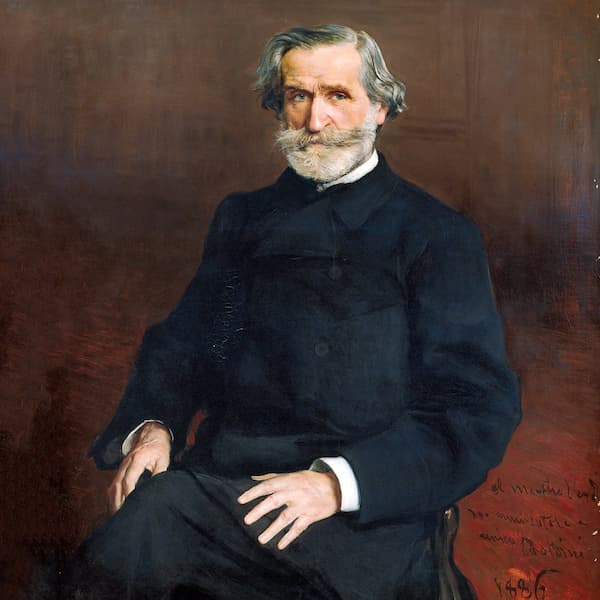
Verdi’s melodic mastery was closely tied to his unparalleled ability to build dramatic tension through his music. His operas are full of moments where melody and narrative intertwine so seamlessly that the music becomes an extension of the character’s emotions, making the drama feel immediate and real. Unlike many of his contemporaries, Verdi never saw melody as mere decoration; it was the heartbeat of the drama itself.
His ability to create melodies that are both sweeping and intimate, fiery and tender, is why his operas continue to stir audiences today, proving that the true brilliance of Verdi lies in the way his music transcends the stage and speaks directly to the heart. As we commemorate Verdi’s passing on 27 January, we decided to feature his 10 most popular melodies.
“La donna è mobile” from Rigoletto
A tragic story of jealousy, vengeance and sacrifice, Rigoletto is one of Verdi’s most popular operas. In fact, when it premiered in Venice at La Fenice on 11 March 1851 to a full house, the aria “La donna è mobile” was so popular that people were heard singing it in the streets the next morning. Verdi immediately knew that he had a hit on his hands.
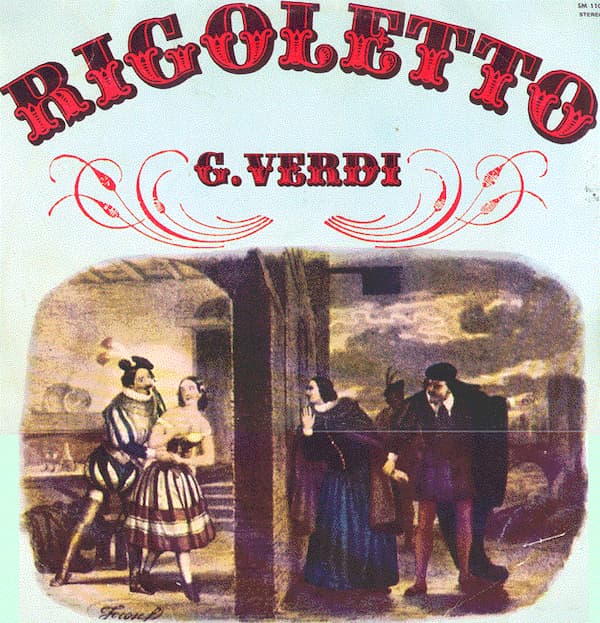
Giuseppe Verdi’s Rigoletto
Verdi had discovered the gripping story of lust and revenge in 1850. He wrote to his librettist Francesco Maria Piave “I have another subject that would be one of the greatest creations of modern theatre. The subject is grand, immense, and has a character who is one of the greatest creations that the theatre in any county or period could boast.”
The famous aria “La donna è mobile” is sung by the Duke of Mantua and reflects his character’s fickle and carefree nature when it comes to love. In the aria, the Duke sings that women are “unpredictable” and “changeable,” likening their hearts to a feather in the wind. His attitude reveals his superficial and manipulative approach to relationships. The melody is lively and catchy, contributing to the Duke’s charming yet shallow persona.
“Va, Pensiero” from Nabucco
For Verdi, “Nabucco was the true beginning of my artistic career.” It signalled the true emergence of his distinctive voice. A scholar writes, “The essential ingredients of Verdi’s early style are in place: a new and dynamic use of the chorus, an extraordinary rhythmic vitality and, above all, an acute sense of dramatic pacing.”
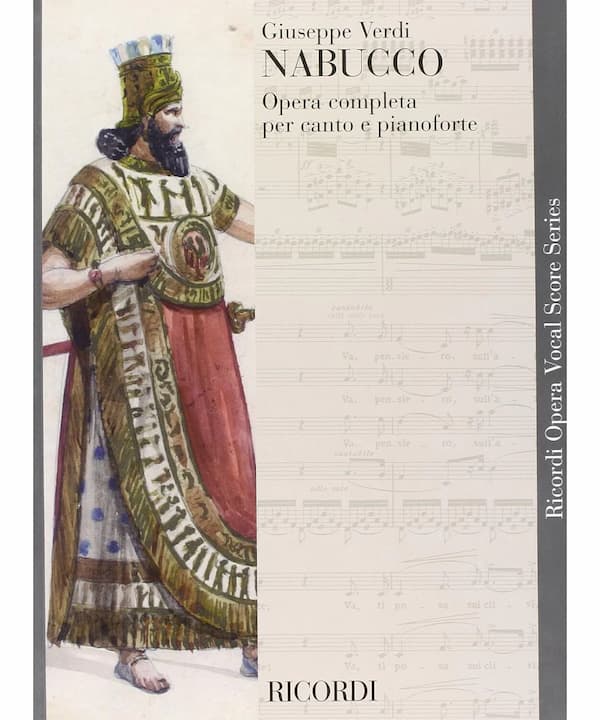
Giuseppe Verdi’s Nabucco
The story is set in ancient Babylon and centres on the conflict between the Babylonian king Nabucco and the Israelites, who are exiled from their homeland. Nabucco attempts to conquer Jerusalem and enslave the Hebrews. His daughter Fenena is in love with Ismael, which complicates matters. Nabucco’s power falters when he declares himself a god, leading to his descent into madness. Ultimately, he is humbled, and the Israelites are freed.
The opera is known for its dramatic choruses, especially the famous “Va, Pensiero,” the “Chorus of the Hebrew Slaves.” The chorus, lamenting their lost homeland and yearning to return to Jerusalem, expresses deep sorrow and longing for freedom. Reflecting personal and collective anguish, it is an emotional plea, a symbol of hope and resistance. “Va, Pensiero” became so popular that it was viewed as an unofficial anthem for the Italian unification movement in the 19th century.
Brindisi (Drinking Song) from La Traviata
Giuseppe Verdi’s opera La Traviata is based on a semi-autobiographical novel by Alexandre Dumas. It tells the story of Violetta Valéry, a beautiful courtesan who falls in love with Alfredo Germont, a young man from a respectable family. Alfredo convinces her to leave the life of a courtesan, but his father Germont is horrified by the scandal caused by the illicit relationship. He convinces Violetta to leave Alfredo, who believes she has left him for another man. They are finally reconciled, but she dies in his arms of consumption.
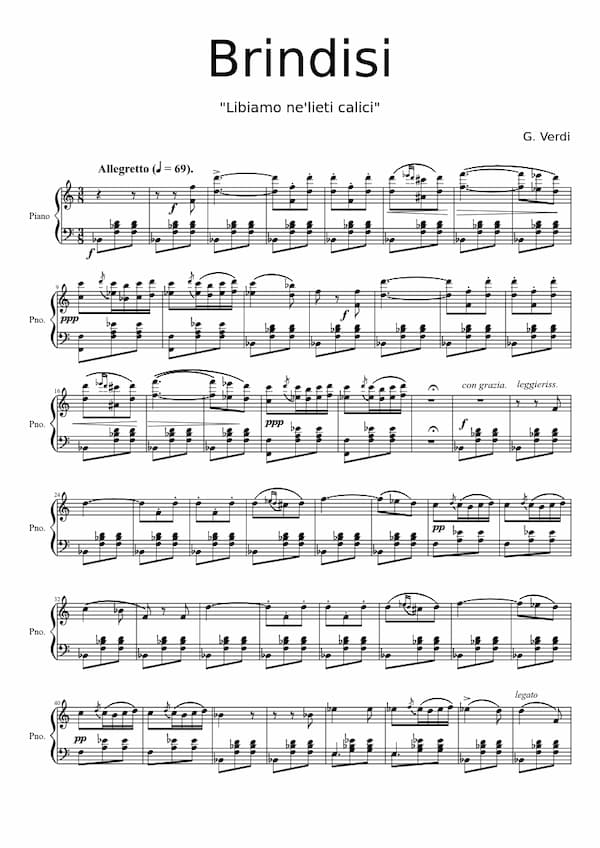
Verdi’s La Traviata – Brindisi music score excerpt
The Brindisi is one of the most famous musical numbers from Verdi’s pen, a quintessential example of Verdi’s skill in crafting vibrant and engaging ensemble pieces. The drinking song is set in a scene where Alfredo and Violetta are celebrating a lavish party alongside a group of their friends. Alfredo is besotted with Violetta, and the drinking song becomes a symbol of carefree joy, love, and revelry.
The Brindisi features a lively, catchy melody with bold rising motifs and playful ornamentation, capturing the festive spirit. The orchestration includes bouncy strings and woodwinds, with brass and percussion adding brightness. The harmony is simple, and a lively rhythm with syncopation contributes to the drinking atmosphere. It is one of Verdi’s most memorable and dynamic melodies, combining joy, elegance, and foreshadowing in a way that only Verdi could achieve.
“Pace, pace mio Dio” from La Forza del Destino
On commission from the Saint Petersburg Imperial Theatre, Verdi collaborated with Francesco Maria Piave on the 1835 Spanish play “Don Alvaro.” It is the story of three people bound together by the power of fate. In order to retain his good family name, the Marchese di Calatrava forbids his daughter Leonora to marry the Latin American Don Alvaro. When the young lovers are attempting to elope, a bullet discharges from Alvaro’s pistol, killing the Marchese. Leonora’s brother immediately seeks to avenge his father, and he ends up killing his sister.
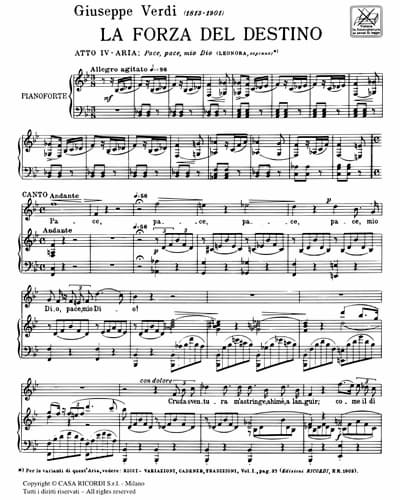
Verdi’s La Forza del Destino – Pace, pace mio Dio music score excerpt
“Pace, pace mio Dio” is a deeply emotional aria sung by the character of Leonora in Act IV. Leonora has fled to a convent in an attempt to escape the violent forces of fate. She is facing both personal despair and imminent danger. She is also consumed by guilt over the death of her father and asks for peace from God, expressing her exhaustion with life’s suffering and seeking solace in the hope of a peaceful death.
It is one of Verdi’s most poignant arias, and its emotional depth lies in its simplicity and directness. The combination of a slow, lyrical melody creates a moment of profound emotional vulnerability. It is an aria of resignation, a surrender to fate. It is a stunning example of Verdi’s ability to blend musical beauty with deep human emotion, creating an aria that is both artistically challenging and profoundly moving.
Anvil Chorus from Il Trovatore
Il Trovatore is set in the Spanish regions of Biscay and Aragon in the 15th century. The plot opens with Ferrando, the captain of the guards, telling the story of a mother burned at the stake for suspected witchcraft. She is avenged by her daughter, Azucena, who throws the child of the executioner into the fire. The child’s father is obsessed with vengeance and forces his surviving son to devote his life to avenging his brother’s death. Once grown, Count di Luna is possessed by this need for vengeance.
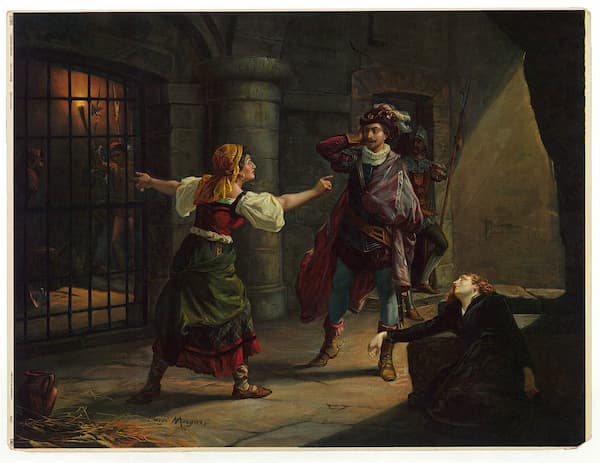
Verdi’s Il trovatore poster
The Anvil Chorus is one of the most famous melodies composed by Verdi. In the context of the opera, the chorus is sung by a group of gypsies who work as blacksmiths. They are hammering anvils in a forge, and the rhythmic clanging of the hammers is mirrored by the music, which gives the piece its distinctive, powerful energy.
The music features a rhythmic pulse resembling anvils being struck, with strong brass and percussion. The chorus alternates male and female voices, with dynamic shifts and powerful vocal moments. The simple, catchy melody and bold harmonies create a triumphant, industrial atmosphere that has become synonymous with the spirit of resilience.
“Caro nome” from Rigoletto
Let us return to Rigoletto for one of the most famous soprano arias composed by Verdi. “Caro nome” is sung by the character Gilda, the innocent and lovesick daughter of Rigoletto. She believes the Duke of Mantua to be a poor student and sees him through a lens of idealised romantic love.
Verdi composed a simple yet elegant melody, its long and sustained notes expressing Gilda’s longing and devotion. The orchestration is delicate and transparent, with strings providing harmonic support that creates an intimate and dreamy atmosphere.
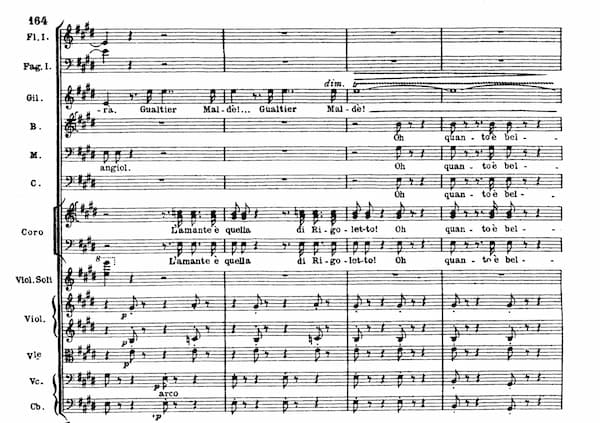
Verdi’s Rigoletto – Caro nome music score excerpt
Once again, Verdi blends lyrical beauty with emotional depth, and “Caro nome” is a moment of lyrical beauty that stands in contrast to the darker themes of the opera. The aria is frequently performed in recitals and concerts, and it remains one of the most beloved pieces in the operatic repertoire.
“O patria mia” from Aida
It’s a myth that Verdi wrote Aida for the opening of the Suez Canal in 1869, as it was actually commissioned for the Khedivial Opera House in Cairo. In the event, Verdi composed one of his operatic masterpieces that tells the story of the love triangle between the captive Nubian princess Aida, the Egyptian princess Amneris, and Radames, the soldier they both love.
One of his most famous arias, “O patria mia” is scored in the key of A-flat Major, a key Verdi often uses for music of deep emotion and grandeur. The orchestral accompaniment is lush and lyrical, enhancing the sense of nostalgia and longing for Aida’s homeland. And just listen to the rich harmonic progressions, which provide a sense of unresolved tension that reflects Aida’s inner turmoil.
“O patria mia” is one of the most poignant and emotionally complex moments in Aida, and it beautifully captures Aida’s sense of loss and longing. The music Verdi composed for this aria is a perfect vehicle for the expression of deep emotional turmoil, combining lyrical beauty with harmonic richness.
“Marcia Trionfale” from Aida
Let’s stay with Aida for our next selection as well. It is almost universally agreed upon that Aida is one of the most popular operas in the world. It features extravagant sets, a huge chorus of performers, and some of the most endearing and beautiful music ever written for the operatic stage.
In the context of Aida, the “Marcia Trionfale” occurs during a pivotal moment in the opera, as the Egyptian forces celebrate a hard-won victory over the Ethiopians. The music, with its bold fanfare and driving rhythms, represents the glory and pride of Egypt. It contrasts starkly with Aida’s emotional turmoil, and Verdi’s composition brilliantly highlights the opera’s central themes of conflict, loyalty, and the personal cost of war.
“Morro, ma prima in grazia” from Un ballo in Maschera
Un ballo in Maschera, translated as “A Masked Ball” is based on the real-life assassination of King Gustav III of Sweden, who was shot during a masked ball in 1792. The operatic story centres on King Riccardo, who secretly loves Amelia, the wife of his friend Renato. Political conspiracies threaten Riccardo’s life, and at a masked ball, Renato, believing Riccardo has betrayed him, kills the king.
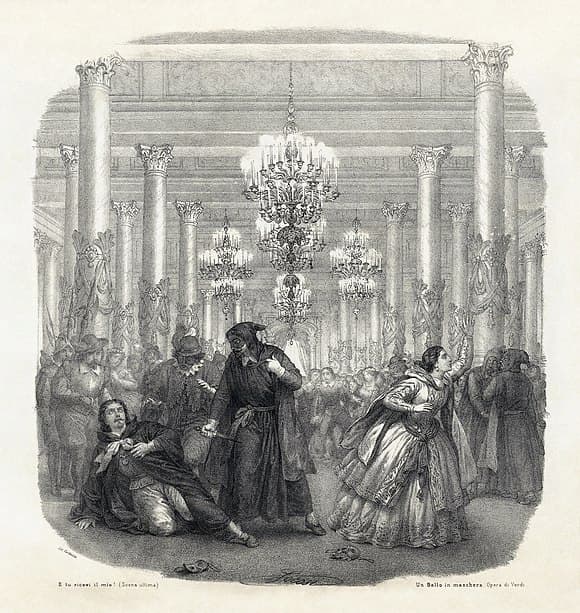
Giuseppe Verdi’s Un ballo in Maschera, vocal score cover
The aria “Morro, ma prima in grazia” (I die, but first with grace) takes place at the moment that Amelia has learned that Riccardo has been marked for death by her husband Renato. She expresses her anguish over her situation in this poignant moment of spiritual reckoning. It is one of the most emotionally intense arias in the opera, with Amelia caught between guilt, love, and the hope for forgiveness.
“Sempre Libera” from La Traviata
Let’s conclude our survey of the 10 most popular melodies with “Sempre libera,” basically meaning “Always Free,” from Verdi’s La Traviata. It is one of the most iconic and challenging arias in the repertoire and is sung by the heroine, Violetta. It marks a pivotal moment in Act 1, when Violetta reflects on her life and freedom and resolves to continue living a carefree, independent existence despite her growing feelings for Alfredo.
The aria is an expression of her inner conflict, as she tries to convince herself that she can remain committed to her hedonistic lifestyle, even though her emotions are beginning to pull her in another direction. Verdi wrote an unforgettable aria whose lyrical melody alternates between moments of carefree joy and intense inner conflict. It all starts confidently, but as the aria progresses, the music becomes more agitated with virtuosic coloratura, highlighting her growing emotional turmoil.
As we have heard, Verdi’s melodic mastery lies in his ability to craft unforgettable, emotionally resonant themes that seamlessly blend with dramatic expression. I trust you enjoyed this little feature, and as always, please let us know your favourite.
For more of the best in classical music, sign up for our E-Newsletter



